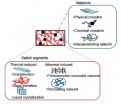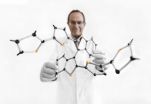(Press-News.org) It's not uncommon these days to find a colored ribbon representing a disease. A pink ribbon is well known to signify breast cancer. But what color ribbon does one think of with lung cancer?
Although white has been identified as the designated color, for many suffering from the disease, black may be the only one they think fits.
A Michigan State University study consisting of lung cancer patients, primarily smokers between the ages of 51 to 79 years old, is shedding more light on the stigma often felt by these patients, the emotional toll it can have and how health providers can help.
"It's eye opening when a patient says to you that they feel like lung cancer 'just gets shoved under the rug,'" said Rebecca Lehto, who led the project and is an assistant professor with MSU's College of Nursing. "Patients in one of the focus groups actually associated lung cancer with a black ribbon."
Previous research has shown that lung cancer carries a stigma. Because lung cancer is primarily linked to smoking behaviors, the public's opinion of the disease can often be judgmental. Today, lung cancer remains the leading cause of cancer death globally.
Yet Lehto indicates that up to 25 percent of lung cancer patients worldwide have never smoked. The World Health Organization has identified air pollution as a cause, and genetics also have been associated with the disease.
"No matter how a patient gets lung cancer, it shouldn't affect the care they receive or the role empathy should play," she said.
Lehto's goal is to raise awareness among health care providers about the additional burden stigma places on patients and develop patient care strategies that strengthen coping skills and symptom management.
"Understanding a disease from the patient's perspective is essential to providing the best medical care to anyone," she said.
The study evaluated feedback from four focus groups; a format Lehto suggests is uncommon in this particular area of research.
"There've been several studies examining lung cancer stigma, but most have relied on survey data" she said. "Most of the groups in this study had three to four people participating and relied on a group dynamic to foster discussion. The sessions actually appeared quite therapeutic…acting more like a peer group."
Lehto's key findings showed participants expressing guilt, self-blame, anger, regret and alienation relative to family and societal interactions. Yet, many also discussed feeling uncomfortable with their health care providers and even feared their care might be negatively affected because of their smoking background.
Although she admits more research is needed with larger, more diverse patient samples, she said her findings can help substantiate the patient perspective on a critical issue that is of sociological importance. Lehto hopes the results will encourage health care providers to examine their own perceptions about lung cancer stigma and be more aware of how it impacts the patient.
"Arming providers with rich, contextual information may help us put biases aside and heighten empathy and understanding," she said. "That would be a step in the right direction."
INFORMATION:
The study is published in a recent issue of the European Journal of Oncology Nursing and was funded by MSU's College of Nursing.
Michigan State University has been working to advance the common good in uncommon ways for more than 150 years. One of the top research universities in the world, MSU focuses its vast resources on creating solutions to some of the world's most pressing challenges, while providing life-changing opportunities to a diverse and inclusive academic community through more than 200 programs of study in 17 degree-granting colleges.
Unraveling the 'black ribbon' around lung cancer
2014-04-17
ELSE PRESS RELEASES FROM THIS DATE:
Some immune cells defend only 1 organ
2014-04-17
Scientists have uncovered a new way the immune system may fight cancers and viral infections. The finding could aid efforts to use immune cells to treat illness.
The research, in mice, suggests that some organs have the immunological equivalent of "neighborhood police" – specialized squads of defenders that patrol only one area, a single organ, instead of an entire city, the body.
Scientists at Washington University School of Medicine in St. Louis have shown that the liver, skin and uterus each has dedicated immune cells, which they call tissue-resident natural killer ...
Deaths from viral hepatitis surpasses HIV/AIDS as preventable cause of deaths in Australia
2014-04-17
The analysis was conducted by Dr Benjamin Cowie and Ms Jennifer MacLachlan from the University of Melbourne and Melbourne Health, and was presented at The International Liver Congress in London earlier this month.
"Liver cancer is the fastest increasing cause of cancer deaths in Australia, increasing each year by 5 per cent, so by more than seventy people each year. In 2014 there was an estimated number of deaths of around 1,500 from liver cancer. The predominant cause is chronic viral Hepatitis," Dr Cowie said.
Hepatitis refers to the inflammation of the liver. Chronic ...
Ancient sea-levels give new clues on ice ages
2014-04-17
International researchers, led by the Australian National University (ANU), have developed a new way to determine sea-level changes and deep-sea temperature variability over the past 5.3 million years.
The findings will help scientists better understand the climate surrounding ice ages over the past two million years, and could help determine the relationship between carbon dioxide levels, global temperatures and sea levels.
The team from ANU, the University of Southampton (UoS) and the National Oceanography Centre (NOC) in the United Kingdom, examined oxygen isotope ...
Scientists find new way to fight malaria drug resistance
2014-04-17
An anti-malarial treatment that lost its status as the leading weapon against the deadly disease could be given a new lease of life, with new research indicating it simply needs to be administered differently.
The findings could revive the use of the cheap anti-malarial drug chloroquine in treating and preventing the mosquito-bourne disease, which claims the lives of more than half a million people each year around the world.
The parasite that causes malaria has developed resistance to chloroquine, but research carried out at the Australian National University (ANU) ...
Newlyweds, be careful what you wish for
2014-04-17
A statistical analysis of the gift "fulfillments" at several hundred online wedding gift registries suggests that wedding guests are caught between a rock and a hard place when it comes to buying an appropriate gift for the happy couple. The details reported in the International Journal of Electronic Marketing and Retailing suggest that most people hope to garner social benefits of buying an expensive gift that somehow enhances their relationship with the newlyweds while at the same time they wish to limit monetary cost and save money.
Yun Kyung Oh of the Department of ...
More research called for into HIV and schistosomiasis coinfection in African children
2014-04-17
Researchers from LSTM have called for more research to be carried out into HIV and schistosomiasis coinfection in children in sub-Saharan Africa. In a paper in The Lancet Infectious Diseases LSTM's Professor Russell Stothard, working with colleagues in the department of Parasitology and researchers from Cape Western Reserve University, in Cleveland Ohio, University of Cambridge and the Royal Veterinary College looked at previous research into the joint burden of HIV/AIDS and schistosomiasis of children, and found that while disease-specific control interventions are continuing, ...
Biomedical applications of shape-memory polymers: How practically useful are they?
2014-04-17
Polymers that exhibit shape-memory effect (SME) are an important class of materials in medicine, especially for minimally invasive deployment of devices. Professor Subbu Venkatraman and his group from School of Materials Science and Engineering, Nanyang Technological University presented a review article surveying the clinical applications of the SME and addressing critically the question of its utility in implantable devices. Their work, entitled "Biomedical applications of shape-memory polymers: How practically useful are they?", was published in SCIENCE CHINA Chemistry.2014, ...
More effective kidney stone treatment, from the macroscopic to the nanoscale
2014-04-17
Researchers in France have hit on a novel method to help kidney stone sufferers ensure they receive the correct and most effective treatment possible.
Kidney stones represent a major medical problem in the western and developing world. If left untreated, apart from being particularly painful, they can lead to renal failure and other complications. In many patients treated successfully, stone recurrence is also amajor problem. Clearly a more effective pathological approach to diagnosis and treatment needs to be identified to ensure successful eradication of stones.
Worldwide ...
Structure of sodium channels different than previously believed
2014-04-17
Sodium channels are implicated in many serious conditions such as heart disease, epilepsy and pain, making them an important potential target for drug therapies. Unfortunately, there is still much scientists do not know about the molecules. New Cambridge research provides fresh and unexpected insight into the structure of sodium channels and, specifically, one of its components - β-subunit molecules - which are responsible for 'fine-tuning' the activity of the channel. The research is published in the most recent edition of the Journal of Biological Chemistry.
Nerves ...
Chiral breathing: Electrically controlled polymer changes its optical properties
2014-04-17
Electrically controlled glasses with continuously adjustable transparency, new polarisation filters, and even chemosensors capable of detecting single molecules of specific chemicals could be fabricated thanks to a new polymer unprecedentedly combining optical and electrical properties.
An international team of chemists from Italy, Germany, and Poland developed a polymer with unique optical and electric properties. Components of this polymer change their spatial configuration depending on the electric potential applied. In turn, the polarisation of transmitted light is ...




